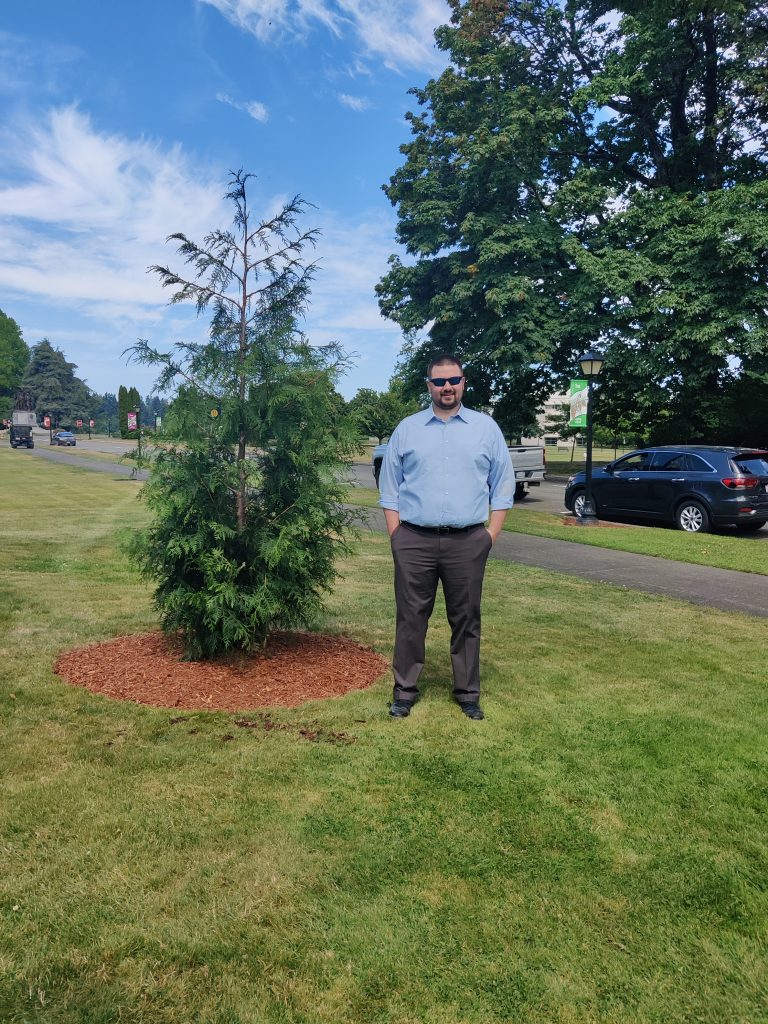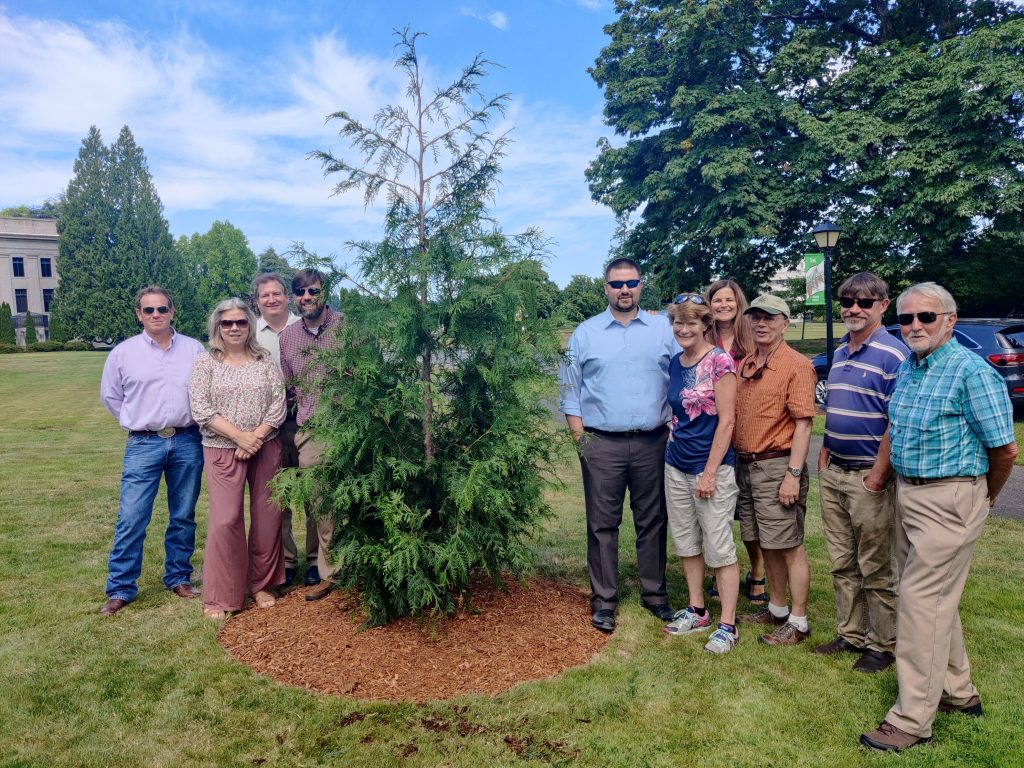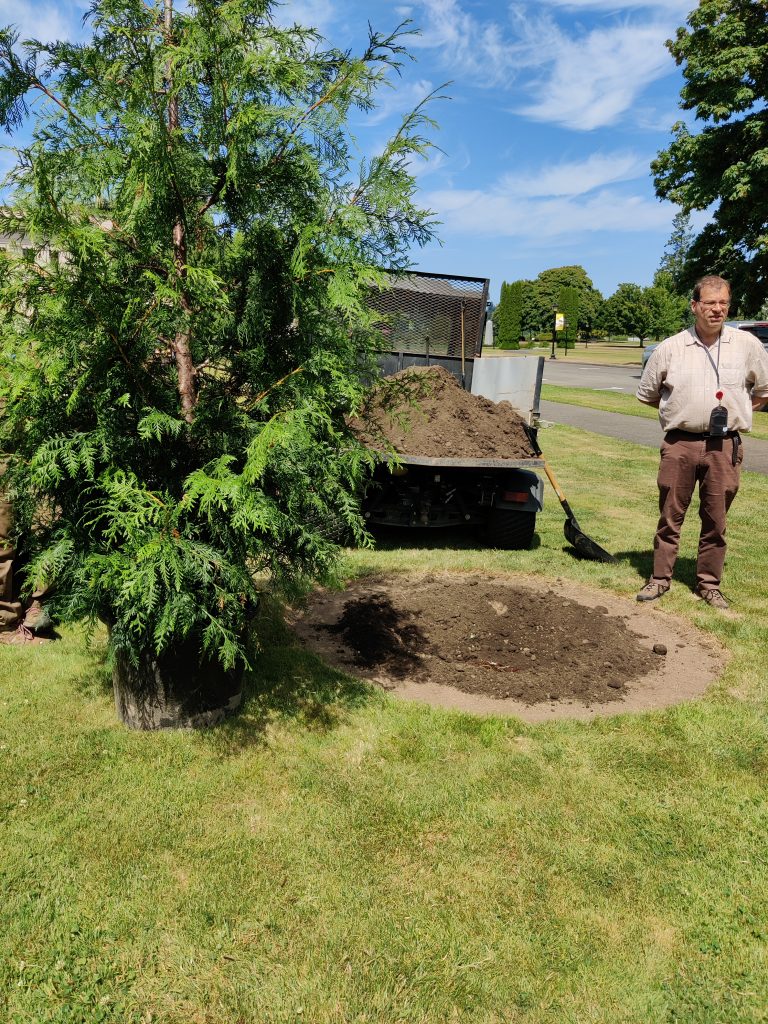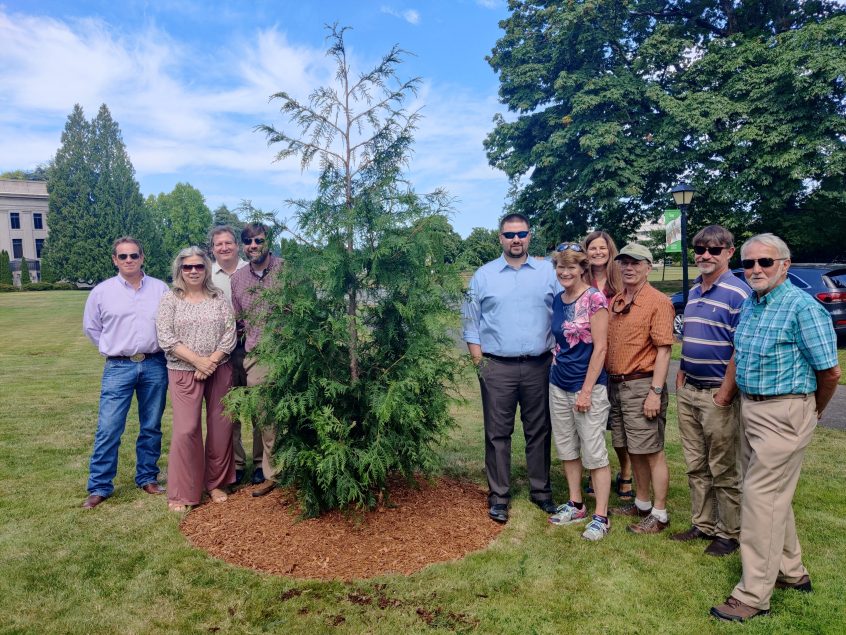Former Washington Forest Protection Association (WFPA) executive director and Washington State legislator Mark Doumit was quoted as saying: “It’s an act of faith when a farmer, a tree farmer, plants a tree.”
Doumit, a former small tree farmer and state legislator, served in the Washington State Legislature from 1997 through 2006, where he served three terms as a state representative and one term as the state senator for the 19th legislative district. During his tenure in the Legislature, Doumit chaired the House Natural Resources Committee and sponsored the landmark Forests & Fish Law legislation, which helped preserve more than 60,000 miles of streams running through 9.3 million acres of private and public forestland.

Matt Doumit stands next to the Western red cedar planted in his father’s honor at the West Capitol Campus.
In 2006, Doumit left the Legislature to serve as the executive director for the WFPA, a nonprofit organization advocating on behalf of Washington state’s private forestland owners. Doumit, 59, unexpectedly passed away in June.
It was a fitting tribute for Doumit, then, that a tree was recently planted on the Washington State West Capitol Campus in his memory.
The Western red cedar was planted by the state Department of Enterprise Services (DES), with members of Doumit’s family and former colleagues in attendance. Western red cedars, an indigenous Pacific Northwest evergreen, can grow up to 200-feet-tall and have been known to live up to 1,500 years.
“Trees are a living memorial,” said Brent Chapman, Washington State Capitol Campus horticulturalist and grounds manager. “The Western red cedar planted in honor of Mark Doumit was intentionally planted in a visible place as part of the landscape that will be incorporated into a new woodland edge planting. This tree will continue to sequester carbon for decades and decades, if not hundreds of years.”
The Doumit cedar tree will fit into a broader, 50-acre historic West Campus landscape design developed over 100 years ago by the Olmsted Brothers firm, Chapman said. The Olmsted Brothers wanted to replicate a forest with big trees, understory trees and ground covers along the perimeter of West Campus.
According to Chapman, the Olmsted Brothers envisioned that the campus landscaping would help frame the magnificent Capitol Building, with people taking an opportunity to pause at the woodland edge of campus and then view the famous Capitol dome as they emerged from the woodland edge and walked toward the great lawn.
“Anytime you plant a tree, it is special,” Chapman said. “But to plant a tree that adds to the campus master plan and helps fulfill the Olmsted vision for West Campus is truly extraordinary.”

Several of Mark Doumit’s WFPA colleagues and family members stand next to the newly planted tree.
In 1911, the state began efforts to create a unique Capitol Campus that paid homage to Washington state’s historical ties to forests and the sweeping views of the Cascade and Olympic Mountain ranges. Even though the Washington State Legislature adopted guiding principles of the Olmsted Brothers’ master landscape plan in the 1920s, funding dried up because of the Great Depression.

Washington State Capitol Campus horticulturalist and grounds manager Brent Chapman shares the history of the West Capitol Campus and the Olmstead vision in advance of planting Mark’s Western red cedar.
To date, less than half of the Olmsted vision is complete on West Campus. But recent funding from the state Legislature and a partnership with the Department of Natural Resources Urban and Community Forestry program has allowed DES, which manages the Capitol Campus, to continue to make strides toward completing the Olmsted vision. DES also reviews proposals for and plants memorial trees, which are paid for by the party who proposes the tree. Memorial trees can be incorporated into that vision.
“There’s no timeline laid out when the master landscape plan will be complete,” Chapman said. “But the DES grounds staff who plant and care for the trees will continue to implement the plan over time using our normal operating budget and working with our partners.”
The campus was listed as a National Register Historic District in 1974. The registry cites the iconic and breathtaking views of Mt. Rainier, the Olympic Mountains, Capitol Lake, tall evergreen trees and the prominent Capitol Dome as notable features.
You can learn more about the West Campus Master Plan and the Olmsted Vision by clicking here. In addition, DES offers in-person horticultural tours by appointment only, where you can learn more about the Capitol campus’ significant trees and the Olmsted vision. DES also offers virtual tours of campus accessible via desktop or mobile device.
